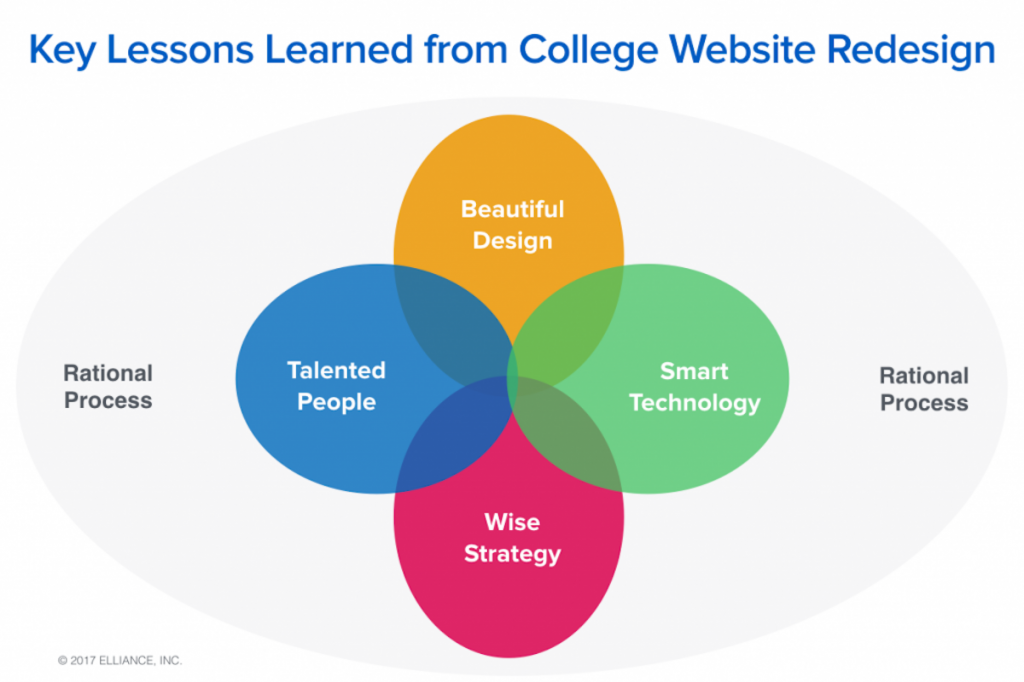| Dec 18, 2017
Key Lessons Learned from College Website Redesign

In working with over 100 colleges in the last 25 years, we have learned that website projects are a catalyst for transforming a college — stakeholders are aligned, power structures are reconsidered, the organization is energized, a new inflection point is created, and destiny becomes attainable.
To realize the true promise of redesigning your website, five essentials are necessary:
Wise Strategy
Revenue Strategy, Communication Strategy and Search Engine Ranking Strategy are the three building blocks of a Website Strategy.
In redesigning your website, these three components must be orchestrated, prioritized and baked into every aspect of development and design.
Ultimately, you become the story you choose to tell, and that story begins with wise strategy.
Beautiful Design
Strategy is invisible. Good design makes it visible.
Milton Glaser once said “There are only three reactions to a piece of design: no, yes or WOW! Wow is one to aim for.” We agree. Responsive, mobile first, and beautiful design deepens meaning, delights people and influences the Google bot to rank your website higher.
Rational Process
These five issues must be managed to reduce project risk:
1. Stakeholder Alignment: Deft diplomacy and discipline are required to ensure that consensus is built across all project stakeholders. All key departmental/university business, brand and technology stakeholders must be involved in discovery, strategy, creative presentations, and final launch for the project to be successful. It’s vital that the design be flexible enough to enable Deans and content creators to shape the user experience in accordance with their visions and needs. It should never be a one-size-fits-all proposition.
2. Content Plan: Creating a detailed content inventory is an important first step in a website project. It forms the basis for deciding on what content will be migrated, adapted, archived or needs to be created. A redesign is an opportunity to modernize your brand story and your unique selling proposition.
3. Critical Site Launch Details: A detailed plan must be established to ensure the current inbound links, SEO rankings, and social share counts are carried forward to the new website.
4. Thorough Testing: User testing, ADA compliance testing, style compliance testing all ensure brand trust. Using mutually agreed-upon tools and processes helps eliminate surprises.
5. Consistent Project Management: Project milestones and weekly status calls are a key staple of successful web projects. Folding side-conversations into these calls prevents downstream challenges.
Smart Technology
These four issues must be managed to insure your success:
1. The Right Systems Architecture: to support centralized services (news and events, course catalogs, faculty bios, admission and giving intakes and more), strategic objectives (faculty experts, media relations), audience separation (prospective students vs. current students/faculty/staff), etc.
2. The Right Customization: to ensure various audiences, schools, departments and centers of excellence all receive the attention they deserve.
3. The Right Domain Architecture: to enable rational content management, maximize SEO rankings, and strengthen marketing campaigns.
4. The Right CMS: which aligns with university’s technology choices, talent and processes — and plays well with tools such as social media, Analytics, lead attribution, marketing automation, CRM, and ERP.
Talented People
To build a great website, it takes a village of craft-minded people on both the client and agency side. Destiny-changing websites are created when inch-wide, mile-deep talent collaborates and are quarter-backed by a strategist and project manager who ensure the team’s focus is unwavering. In a fruitful partnership, good clients and good agencies push each other to up each other’s game and walk away smarter than they were before.
Like any process, the process of redesigning a website will only be as good as the people participating in it. Elliance craft-minded people pay meticulous attention to the details at every step, and work carefully to minimize client risk while liberating their greatness.
If you are seeking college website design agency, please see our work and consider partnering with us.
